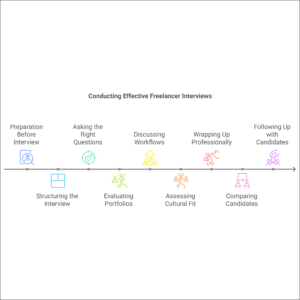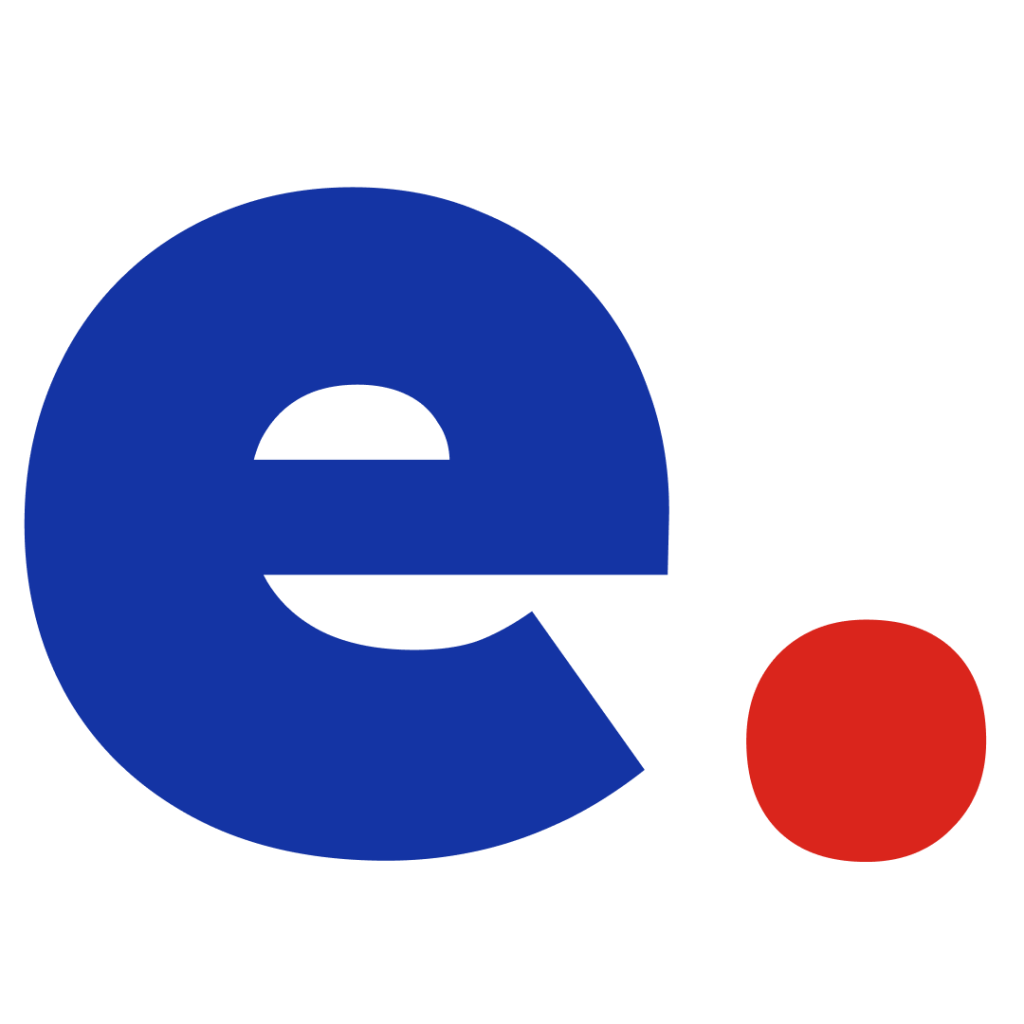Hiring the right freelancer for your business can feel like finding a needle in a haystack. Freelancers come from diverse backgrounds, skill levels, and industries, which means it’s critical to dig beneath the surface and assess whether a candidate truly aligns with your project needs. The interview process is your opportunity to go beyond resumes and portfolios to gauge expertise, communication skills, and cultural fit.
However, interviewing freelancers requires a slightly different approach than traditional job interviews. Since freelancers often work remotely, manage their own time, and handle multiple clients, your interview questions need to focus on their ability to deliver results and work independently.
In this article, we’ll explore the best practices for conducting effective freelancer interviews, from preparation to asking the right questions, so you can confidently choose the right person for your project.

Why Effective Interviews Are Crucial for Hiring Freelancers
Unlike hiring full-time employees, choosing the right freelancer hinges on identifying a balance between technical expertise, communication skills, and reliability. A poorly conducted interview can lead to:
Missed Deadlines: If the freelancer doesn’t have the skills or bandwidth to deliver on time.
Subpar Work Quality: If you fail to assess their expertise thoroughly.
Miscommunication Issues: If expectations aren’t aligned during the interview.
An effective interview sets clear expectations, reduces uncertainty, and helps establish a strong foundation for a successful working relationship.
Step 1: Prepare Before the Interview
Preparation is key to a productive interview. The more organized you are, the easier it will be to evaluate candidates and identify the right fit.
Define Your Project Scope
Before interviewing freelancers, ensure you have a clear understanding of your project.
What are the deliverables?
What’s your timeline and budget?
Are there specific skills or experience required?
Example: If you’re hiring a graphic designer to create social media graphics, specify the number of designs, style preferences, and deadlines.
Review Their Application and Portfolio
Take time to review the freelancer’s resume, portfolio, or profile. Look for examples of similar work, testimonials, or specific achievements. This will help you tailor your questions to their background and avoid asking for redundant information they’ve already provided.
Prepare Key Questions
Draft a list of questions that align with the skills, experience, and qualities you’re seeking. Focus on open-ended questions to encourage detailed responses.
Step 2: Structure the Interview
A structured interview helps you stay organized, maintain focus, and evaluate candidates consistently.
Recommended Interview Structure:
Introduction (5 Minutes):
Briefly introduce yourself, your business, and the project.
Share what you’re looking for in a freelancer.
Discussion of Experience (10–15 Minutes):
Ask the freelancer about their relevant skills, past projects, and how they approach similar work.
Skill-Specific Questions (10–15 Minutes):
Dive into technical or niche questions based on the requirements of your project.
Client-Freelancer Collaboration (5–10 Minutes):
Discuss workflows, communication preferences, and tools to assess compatibility.
Q&A (5 Minutes):
Allow the freelancer to ask questions about the project, timeline, or expectations.
Step 3: Ask the Right Questions
The questions you ask during a freelancer interview should focus on three key areas: skills, problem-solving, and reliability.
Skills and Experience Questions
These questions help you assess whether the freelancer has the technical expertise and industry knowledge to handle your project.
“Can you walk me through a similar project you’ve worked on?”
“What tools or software do you typically use for projects like this?”
“How do you stay updated on industry trends or advancements in your field?”
Problem-Solving and Creativity Questions
Freelancers often need to think independently and solve problems without direct supervision. These questions help you evaluate their critical thinking and creativity.
“Can you share an example of a challenge you faced on a past project and how you resolved it?”
“If a client provides vague or unclear instructions, how do you handle it?”
“What’s your process for incorporating client feedback, especially if it contradicts your professional opinion?”
Communication and Reliability Questions
Strong communication is vital for remote work. Use these questions to gauge how well the freelancer can collaborate and meet deadlines.
“What’s your typical turnaround time for a project like this?”
“How do you prefer to communicate during a project (e.g., email, Zoom, Slack)?”
“How do you handle multiple deadlines or conflicting priorities?”
Step 4: Evaluate Their Portfolio During the Interview
A freelancer’s portfolio is one of the best indicators of their capabilities. Use the interview to dig deeper into their work samples and understand how they approach their craft.
How to Review a Portfolio:
Ask Contextual Questions:
“Can you explain your role in this project?”
“What were the goals, and how did you achieve them?”
Assess Results:
Look for measurable outcomes, such as increased sales, improved engagement, or successful launches.
Evaluate Alignment:
Does their style, tone, or technical approach match your project’s needs?
Example Dialogue:
“I noticed you designed a series of infographics for a SaaS company. Could you share how you developed the concept and ensured the designs aligned with the brand’s goals?”
Step 5: Discuss Workflows and Expectations
Top freelancers value clarity, so use the interview to discuss how you’ll work together and ensure alignment on key expectations.
Topics to Cover:
Project Timelines:
Confirm deadlines and any critical milestones.
“Are you comfortable delivering the first draft by [specific date]?”
Communication Cadence:
Discuss how often you’ll check in and through which platforms.
“Would you be available for weekly check-ins via Zoom to discuss progress?”
Feedback Process:
Clarify how feedback will be shared and incorporated.
“Do you typically include revisions in your project fee, or are they billed separately?”
Time Commitment:
If the project is ongoing, confirm the freelancer’s availability.
“Are you available to work 10–15 hours per week for the next three months?”
By aligning on workflows and expectations, you minimize the risk of miscommunication down the road.
Step 6: Assess Cultural Fit
While technical skills are critical, cultural fit is equally important especially if the freelancer will be collaborating with your team or representing your brand.
How to Evaluate Cultural Fit:
Values and Work Ethic: Ask about their approach to deadlines, client relationships, and quality standards.
Team Collaboration: If the freelancer will work with others, discuss how they handle teamwork.
Example Questions:
“What does your ideal client relationship look like?”
“Have you worked with teams before? If so, how do you ensure smooth collaboration?”
Step 7: Wrap Up the Interview Professionally
At the end of the interview, thank the freelancer for their time and let them know the next steps.
What to Include in Your Closing:
Timeline: Share when they can expect to hear back from you.
Next Steps: Mention whether there will be another round of interviews, a skills test, or an immediate decision.
Encourage Questions: Ask if they have any final questions or concerns.
Example:
“Thank you for taking the time to speak with me today. I enjoyed learning about your experience and approach. I’ll be reviewing all candidates this week and will get back to you by [specific date]. Please don’t hesitate to reach out if you have any additional questions in the meantime.”
Step 8: Evaluate and Compare Candidates
After completing the interviews, take time to compare candidates based on their skills, experience, and overall fit.
How to Evaluate Freelancers:
Skills Match: Do they meet the technical requirements of your project?
Communication: Did they communicate clearly and professionally during the interview?
Cultural Fit: Did their values align with your company’s goals?
Portfolio Strength: Does their past work demonstrate high-quality results?
Create a scoring system or checklist to rank candidates objectively.
Step 9: Follow Up with All Candidates
Once you’ve made your decision, follow up with both successful and unsuccessful candidates. This demonstrates professionalism and ensures you leave a positive impression.
Example for Selected Freelancer:
“Congratulations! I’m excited to work with you on this project. Let’s schedule a follow-up meeting to finalize the contract and get started.”
Example for Unsuccessful Candidates:
“Thank you for taking the time to interview with us. While we’ve decided to move forward with another candidate, we were impressed by your experience and hope to stay in touch for future opportunities.”
Conclusion
Conducting effective freelancer interviews is about more than just evaluating skills it’s about building trust, setting expectations, and ensuring a successful collaboration. By preparing thoroughly, asking the right questions, and assessing both technical and cultural fit, you can confidently select the freelancer who will deliver exceptional results for your project.
Remember, the interview process is a two-way street. While you’re evaluating freelancers, they’re also evaluating you. A professional, organized, and respectful interview experience will help you attract top talent and build strong working relationships.
